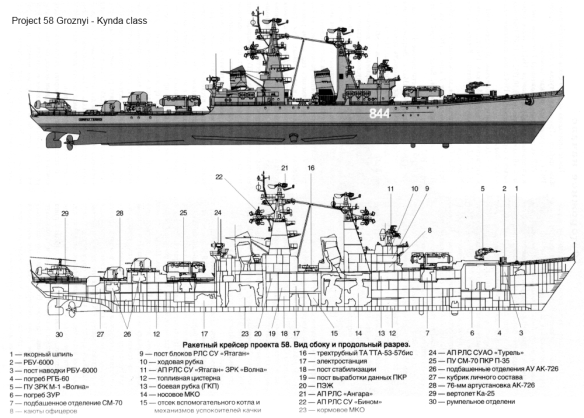
The SS-N–3, known as the Shaddock to the Western powers, produced good results and was ready for service by 1962. This missile, the cruiser version being designated SS-N–3B, was housed in a box launcher. The weapon itself measured 33 feet and contained either conventional or nuclear explosive material, a guidance system that transmitted a radar signature back to the control station located from its firing position for target data, and fuel. Its engines produced a maximum speed of Mach 1.4 and its maximum range was 279 miles. Subsequent versions increased the range of the weapon.
The development of the SS-N–3B led to the world’s first cruisers designed with offensive missile batteries as their primary armament. These were the four ships of the Kynda-class. Completed between 1962 and 1965, their hulls measured 464 feet, 9 inches by 51 feet, 10 inches, displaced 4,400 tons, and were powered by steam turbines that produced a maximum speed of 34 knots. Armament consisted of two SS-N–3B missile launchers that each held four missiles. These box structures were separated into compartments for individual missiles and were mounted on swivel stalks to train the weapons in the direction necessary for firing. One launcher was positioned forward while the other was in the rear. They also mounted an SA-N–1 antiaircraft missile launcher, the product of research in SAM technology. Augmenting this weapons array was an ASW rocket launcher. Known as RBU–6000, it was similar to the U.S. ASROC system and introduced between 1960 and 1961. This weapon, still in use in the Russian Navy, contains 12 rockets that can be fired to a maximum range of almost 5,500 yards. Finally, these vessels mounted four small guns for use at close range.
In truth, the Kynda- and Kresta I-classes were not successful designs. Both had limited offensive value against warships because the SS-N–3B launcher did not incorporate a reloading system. Indeed, this continued to be a problem in most Soviet cruisers. The Kresta I-class vessels shipped no reloads at all. In the Kynda-class, the few missiles that were stored outside the launcher itself were housed in the superstructure on the main deck. The spaces allotted for this purpose could contain a total of only eight missiles. Added to this deficiency was the fact that manual labor, rather than loading machinery, was used to remove missiles from storage and place them in launchers. Not only was this process time-consuming; it was extremely difficult to perform in even moderately rough seas due to pitching and rolling. As the warships of the Soviet Navy operated partly in the Arctic and Atlantic Oceans, rough conditions were the rule rather than the exception. In addition to this limited offensive capability, the Kynda-class vessels shipped poor sonar and radar systems that hampered the use of antiaircraft and ASW systems. Nevertheless, Western naval officials viewed these ships with great concern. Not only did U.S. missile cruisers possess no offensive missile capability to combat the Soviet cruisers; the advent of Soviet missile technology also created a blue-water navy that could shoot down Western aircraft.